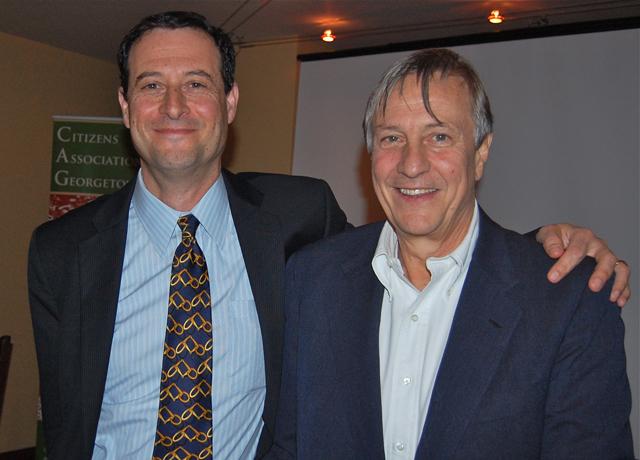Without Upgrades, Georgetown’s Commercial Future Will Be in Peril
By • February 7, 2015 0 3892

Developer Anthony Lanier, founder of EastBanc, and Joe Sternlieb, CEO of the Georgetown Business Improvement District, gave a presentation of Georgetown’s commercial present and future before members and guests of the Citizens Association of Georgetown Nov. 5 at Pinstripes, the Italian bistro and bowling alley on Wisconsin Avenue.
While there has been an influx of new retail shops and a few new restaurants, the trends may not be as positive as they seem, the two business leaders warned toward the end of their talk. For them, it is all about staying current and keeping the crucial upgrades coming — filling in retail spaces here and there — and keeping people coming to Georgetown.
Lanier began the slide show about his company’s properties and upcoming projects with Sternlieb providing statistics on the town’s retail profile and other details. Their presentations were jam-packed with information before the packed room at the restaurant, which is part of the reconstructed Georgetown Park, no longer a mall. (Lanier’s EastBanc is associated with Jamestown Corporation, which now owns Georgetown Park.)
EastBanc recently bought the “Four Seasons gas station,” as Lanier called it, with “the highest price paid for land in D.C.” He said a Portuguese architect is on board for the mixed-use condo design, for which he hoped people would have “an open mind.” That project is at the eastern entrance to Georgetown at 2715 Pennsylvania Ave., NW. Another condo project, its design already approved, is at another gas station — Key Bridge Exxon — 3601 M St., NW, at the western end of the neighborhood.
As for the nearly completed 1055 High residential project at Wisconsin Avenue and the C&O Canal, Lanier said, “Seven condos sold in nine days.”
Other EastBanc properties getting into the pipeline include the renovation of the former Fino’s and Mr. Smith’s. A townhouse at 3246 Prospect St., NW, backs into an alley from Potomac Street. Lanier hopes to re-do the alley between Prospect and M Streets. He also sees Blues Alley, NW, as a “future retail street.”
Joe Sternlieb of the Georgetown BID asked the audience how many had walked to the event, as he mentioned 13,000 persons work in Georgetown. Noting the success of Book Hill and the need for future growth, Sternlieb said that the Georgetown Exxon — at Wisconsin and Q — is under contract to Trammel Crow to become a condo complex.
He said the Marvelous Market property (the former Neam’s Market site, still owned by the Neam family) at Wisconsin and P is under contract and asked anyone with any more information to let him know about the buyers. He also said that the Georgetown Theater retail-condo project by Robert Bell would vastly improve the 1300 and 1400 blocks of Wisconsin Avenue, NW, where some of the nearby businesses like Prince & Princess at Wisconsin and O could become a restaurant if the financial numbers could work (which seems unlikely).
Sternlieb showed the slideshow from the BID’s 2028 presentation, as he spoke about the upcoming Latham apartments at 3000 M St., NW, future retail at 3220 Prospect St., NW, in the parking lot space and the Four Seasons condos in the reconstructed West Heating Plant on 29th Street, NW. He even mentioned that PNC Bank had pondered developing part of its bank parking lot at Wisconsin and M.
The residents of Georgetown cannot support the total retail sales for the commercial space that makes up the town, Sternlieb said. In statistical terms: the U.S. has 53 square feet of retail per capita; D.C., 34; Georgetown, 227. “You guys have to spend a lot more money,” he said. Lanier interjected that Georgetown residents do not frequent enough businesses.
While the population of Washington, D.C., has rebounded, the amount of D.C. neighborhoods that have added retail, such as restaurants and clothing stores, has likewise increased — something on the scale of six or seven in the 1990s to today’s 20 neighborhoods with a significant commercial section.
The new mix of residents, commuters and tourists puts pressure on Georgetown to keep the sales registers humming. “We need a new crowd every day,” Sternlieb said. One point of good news for Georgetown was that it has the lowest office vacancy in D.C.
Sternlieb also cited the low percentages for Georgetown on restaurants and liquor licenses as compared to other D.C. neighborhoods. In Adams Morgan, for example, businesses with liquor licenses are 60 percent of those in the neighborhood, while in Georgetown that same percentile is 14. Of the two stars given by the Washington Post to D.C. restaurants, Georgetown has the lowest percentile of all other neighborhoods: 12 percent of its restaurants got two stars from the Post. This low percentage of liquor licenses to overall businesses was seen by the two speakers as a threat to the retail district.
“We are losing our restaurant community,” Sternlieb said. “Georgetown used to be date night.”
Sternlieb brought up several highly publicized ideas to stay competitive: more liquor licenses should be issued; temporary sidewalk widening of M Street on the weekends; a street car along K Street from Union Station to Georgetown University; a gondola aerial lift above the Potomac from Rosslyn to Georgetown; a large bookstore (if the residents could help with some kind of loan-lease agreement), such as Politics & Prose; maintenance of the C&O Canal and a new canal boat; lastly — and literally lastly — one or two Metrorail stations, which are part of the Metro 2040 Plan (a more or less $3-billion price tag for the aging system).
Lanier noted that foreign investment plays a large role in Georgetown. “We must be commercially viable before we become extinct,” he said.
- Jordan Wright
- Joe Sternlieb, CEO of the Georgetown Business Improvement District, and Anthony Lanier of EastBanc. | Robert Devaney



